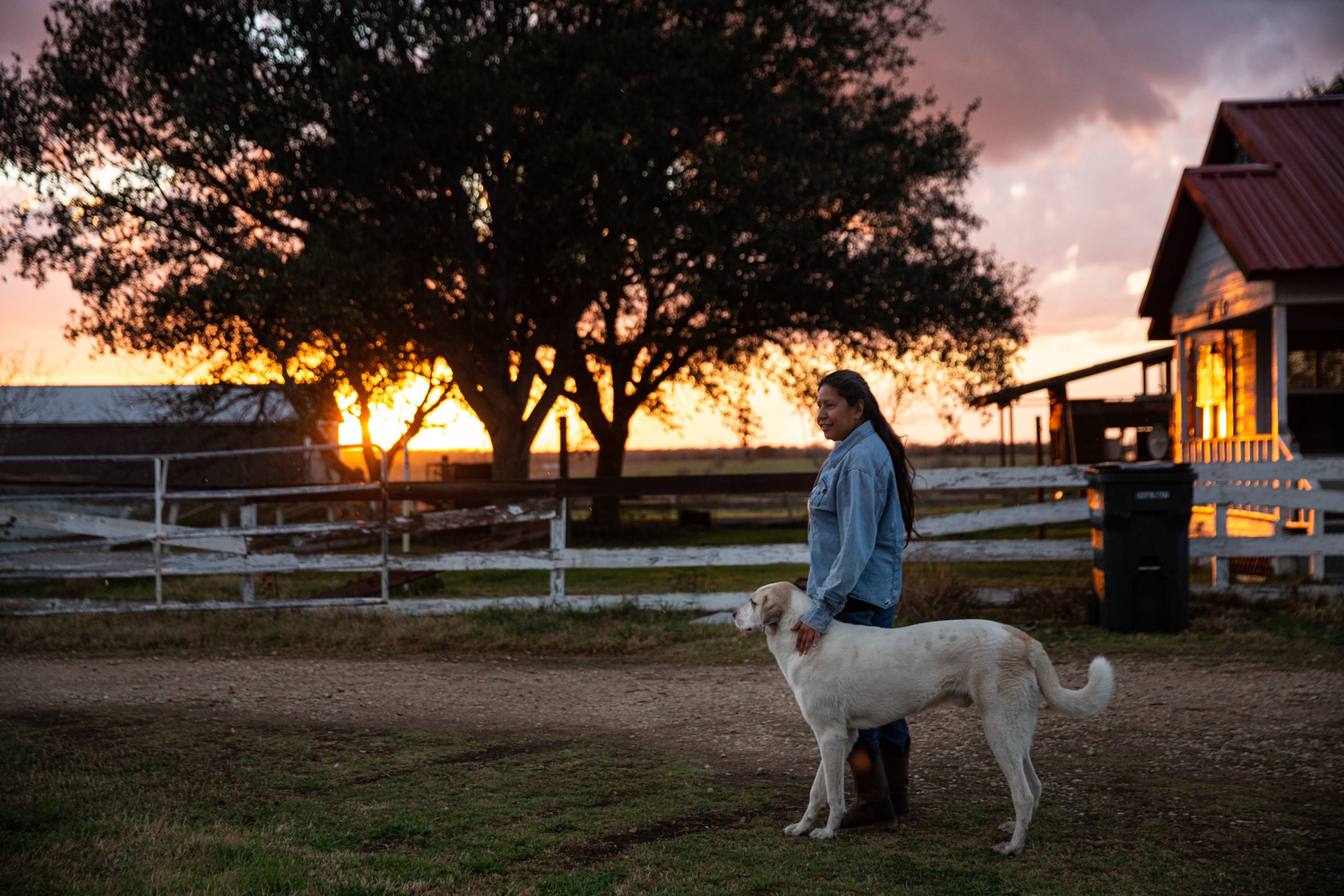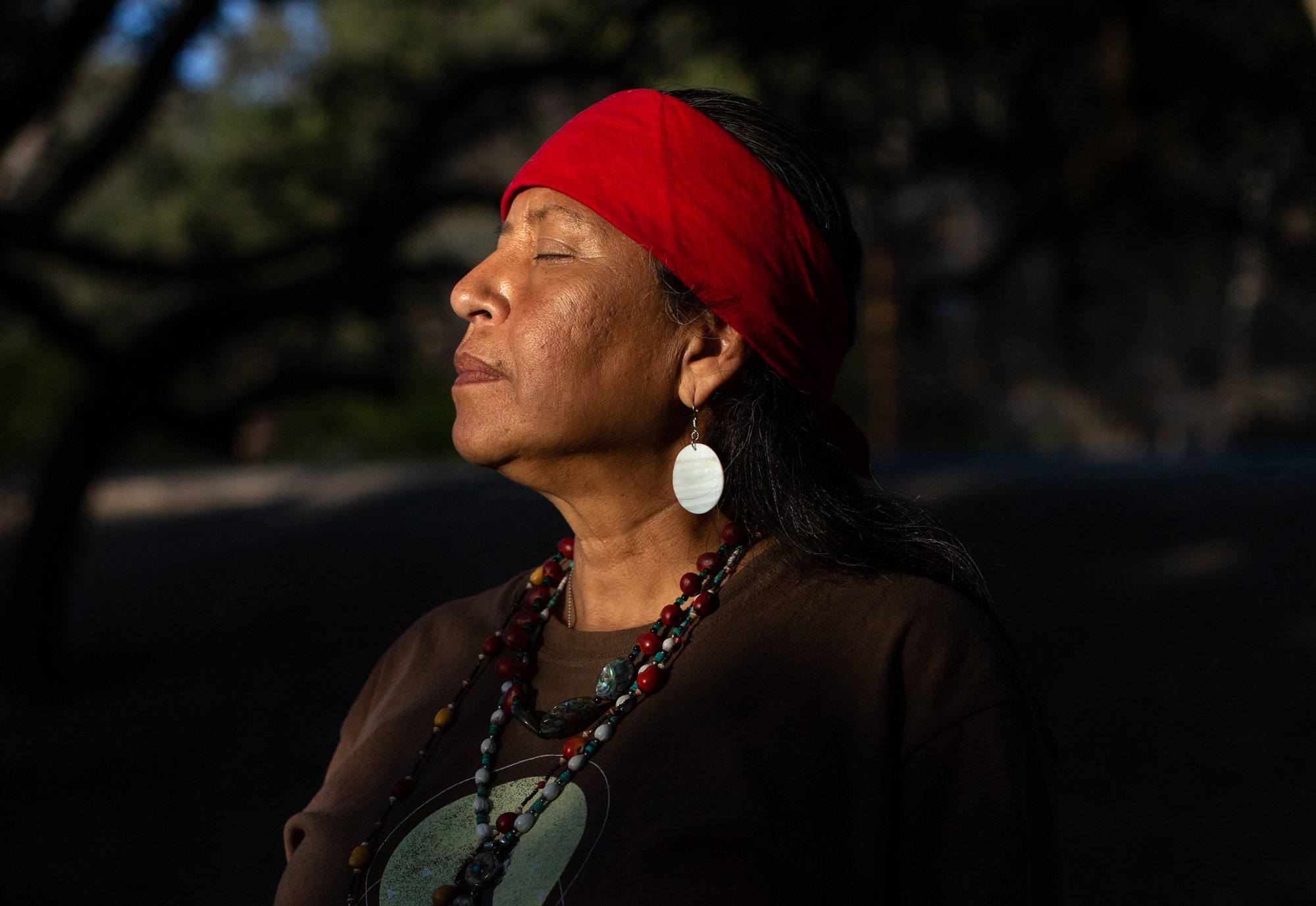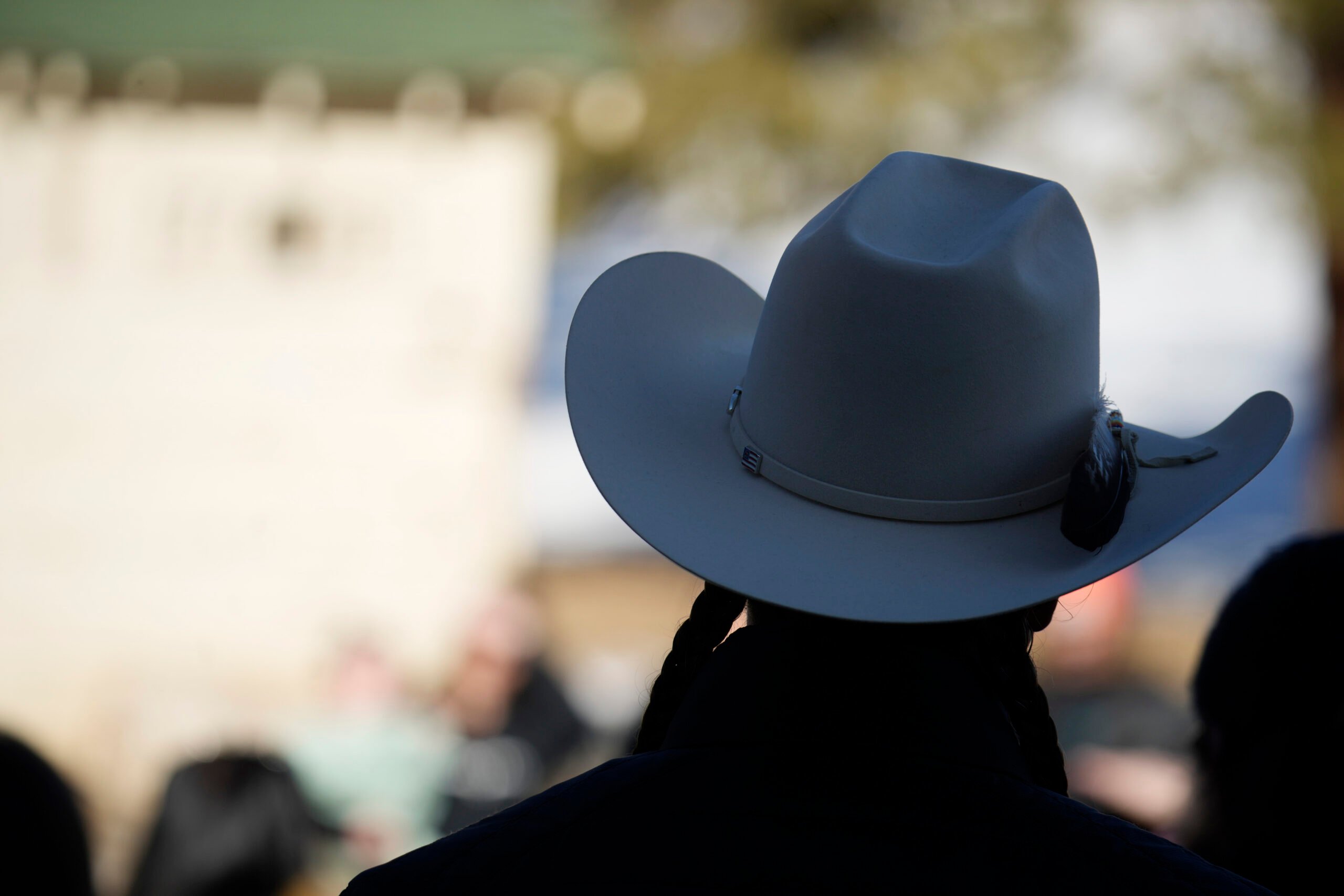The moment seemed to call for drastic action. Lucille Contreras’ youngest son was on his own, ranching buffalo on the Pine Ridge Lakota Reservation in South Dakota where both lived. Her other kids were financially stable. For the first time, this mother of three didn’t have to consider what anyone else wanted.
The COVID-19 pandemic had her locked down and looking every day at the heaping stack of U.S. Department of Agriculture loan application papers that had lingered on her desk for years. Finally, she decided. It was time.
The career computer information tech worker from San Antonio would return to Texas and start to ranch buffalo, just as she’d learned in six years living with the Lakota. She believed her own people, the Lipan Apaches, needed buffalo too.
The Lipan Apache, historically based around Central Texas, are recognized by the state—but not by the federal government. They have no reservation and no unified representation. That means thousands of people with Lipan heritage, like Contreras, live scattered across a state that has historically labeled Native Americans as Mexican immigrants and taught school children that Texas’ tribal people were long gone.
Contreras wanted to show that those myths were false, and that South Texas cultural staples, like the roasted cow heads consumed in barbacoa tamales, the heirloom metate her grandma used to grind corn for tortillas, and the colorful parties thrown for young women coming of age didn’t originate in Spain, but trace back to a time when buffalo roamed all across Texas by the millions. “There’s one thing for sure: The buffalo survived,” Contreras said. “And we as Indigenous people, especially Texas Indigenous, we also survived.”
Since her people didn’t have a reservation to use as a cultural center, Contreras decided to buy land. She acquired 77 acres near the tiny town of Waelder, gathered a small herd of bison, and started the nonprofit Texas Tribal Buffalo Project in March 2021, using a mixture of $580,000 in loans, grants, donations, and support from her Native American activist community.
Her project is only the latest example of the steady re-emergence of the long-hidden Lipan Apache culture in Texas. Thirty years ago, there were no openly Lipan groups here, but several robust communities have since been formed by a generation of people who organized around common oral stories of South Texas Apache ancestry. All are dedicated to rediscovering and reclaiming their pre-colonial roots.
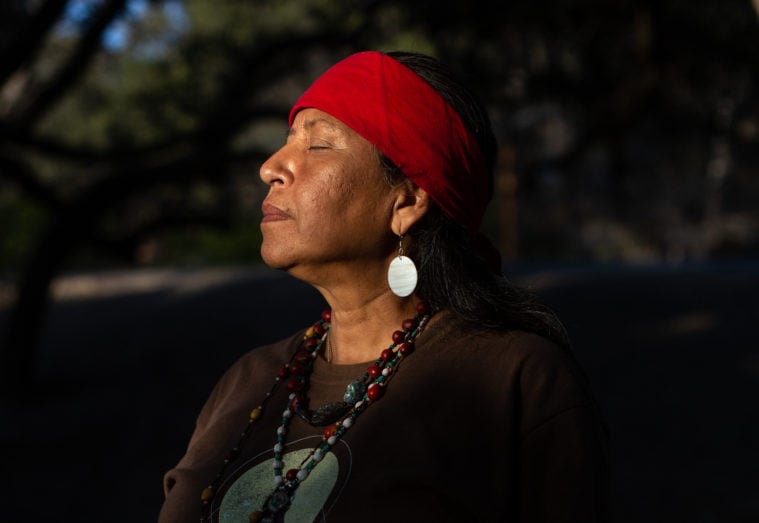
Today, two major Lipan Apache groups have thousands of members: the Lipan Apache Band of Texas, based in tiny Brackettville, 30 miles outside Del Rio, and the Lipan Apache Tribe of Texas, based in McAllen. Two other smaller groups call themselves the Lipan Apache Nation of Texas and the Apache Council of Texas. Contreras is enrolled as a member of the Band.
Contreras, a college graduate, has never been wealthy: She has long been a single mother who worked in elementary school computer labs and later on a college campus.
During a 2021 interview, Contreras smiled warmly as she walked the fenceline of her ranch on the prairie, 80 miles east of San Antonio. A life in agriculture is a dream come true.
“This is the first time in hundreds of years that Lipan Apaches and Southern Plains bison have been right here, on this land,” she said, pointing to the tall grasses beneath her high leather boots.
She said her project comes at a time of reawakening for Native American identity and communities nationwide. Indeed, in Texas, U.S. Census figures show a robust Native population emerging from concealment. Today, more Texans identify as Native than ever before.
Back in 1950, the U.S. Census showed a population of 2,736 American Indians in Texas, of whom 142 were living on the Alabama-Coushatta reservation in the Piney Woods of Polk County—the only reservation in Texas at the time (two more small reservations in the state were founded in 1969 and 1985).
Census takers were instructed back then not to ask about race but to decide for themselves. That was never easy to determine, especially in Texas, where centuries of wars and competing territorial and imperial claims left a complex mixture of overlapping cultures.
They used Texas history as their guide: Texas territory was long linked to Mexico, first under Spanish rule from about 1690 to 1821, and then as part of an independent Mexico from 1821 until the Texas Revolution in 1836.
The idea that original Texans were all Mexicans or Hispanics lingered among U.S. census takers long after Texas rejoined the United States in 1870 after the Civil War.
“Since Texas was part of Mexico, they decided all the Indians were Mexicans,” said Bernard Barcena, chairman of the Lipan Apache Tribe of Texas, who traces his own ancestry to Lipans who settled in San Antonio missions after they were built by Spanish monks in the early 1700s. “They were looked at not as Indigenous people but as Mexican immigrants.”
After the U.S. Census changed in 1970 and race became self-reported, the number of identified American Indians began to rise both in Texas and nationwide.
Figures for Texas show the self-reported American Indian population has grown over 1,500 percent, from 18,000 in 1970 to 295,000 in 2020. They account for one percent of the state’s population today.
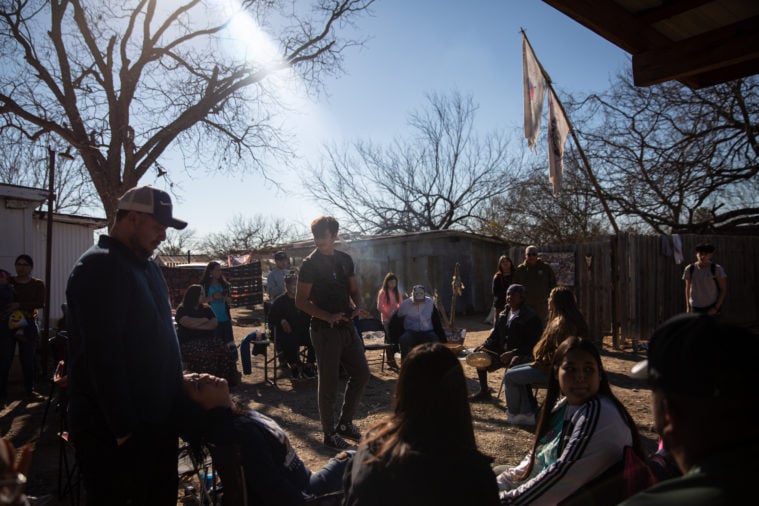
Many American Indians in Texas, like Contreras herself, also identify as Hispanic, which on the census is a separate category that can be chosen by people of any race. Most of those people did not grow up or live on one of Texas’ three tiny reservations.
Many more Texans know they come from Native roots but lack information to claim their heritage, said Hector de Leon, a veteran Houston-based organizer who has been analyzing demographic data on his website and in community talks for decades.
De Leon calls himself Hispanic, but when he talks about Texans’ confusion with Native American racial identity, he speaks from his personal struggles. De Leon gets six options when he fills out the race section of the U.S. Census: Black, White, American Indian, Asian, “two or more races,” or “some other race.” None of these feel right.
His grandparents were rural farmers in Mexico. He was born in the city of Monterrey in Nuevo León, Mexico, but spent the last 50 years on the same street in Houston. He has high cheekbones and a dark earthy skin tone. A test he took a few years ago from 23andMe showed his DNA as 67 percent Native American.
He had always considered marking himself as “American Indian.” But the census asks respondents to specify a tribe and de Leon has no idea.
So instead, he marked “White,” like more than two-thirds of Texas Hispanics in the 2010 Census. He also checked “Hispanic or Latino origin.” He pointed out that about 99 percent of Texans who identified as “Some Other Race” in 2010 also identified as Hispanic—suggesting that many share de Leon’s struggle with whether to select American Indian.
But that struggle is not shared by all Texas Hispanics. For example, de Leon’s wife comes from Cuba. When she took the genome test, it showed she was 100 percent of Southern European origin. She considers herself white and Hispanic. Many others like de Leon, who descended from Spanish colonists and from Native Americans, consider themselves mestizo, an option that isn’t listed on census forms.
“When they talk about the mixed-race population in the U.S., they don’t include me there, they include me in the category of Hispanic,” he said. “So the fact that I am native to the Americas gets lost.”
Reclaiming their Texas Native heritage has taken decades of effort and a revolution in identity for leaders in the Lipan communities of Texas. Leaders of the generation who organized today’s Lipan groups grew up at a time when Indigenous ancestry was often kept secret.
“We grew up thinking we were Hispanics because that’s what we were always being told,” said David Garza, 55, as he flipped chunks of cabrito on a wide charcoal grill outside an old family home in Brackettville, around 20 miles north of the Rio Grande, in February 2022. “It wasn’t until my adulthood I realized why [my parents] kept it from us. They were afraid of getting killed.”
He was grilling on this Sunday morning for a monthly Lipan family reunion. He roasted two cow heads overnight in an underground pit to make barbacoa tacos like his dad used to do. About 45 people turned out, with families drove in from Houston, San Antonio, and Del Rio to this same wooden house where they’ve gathered for more than 50 years.
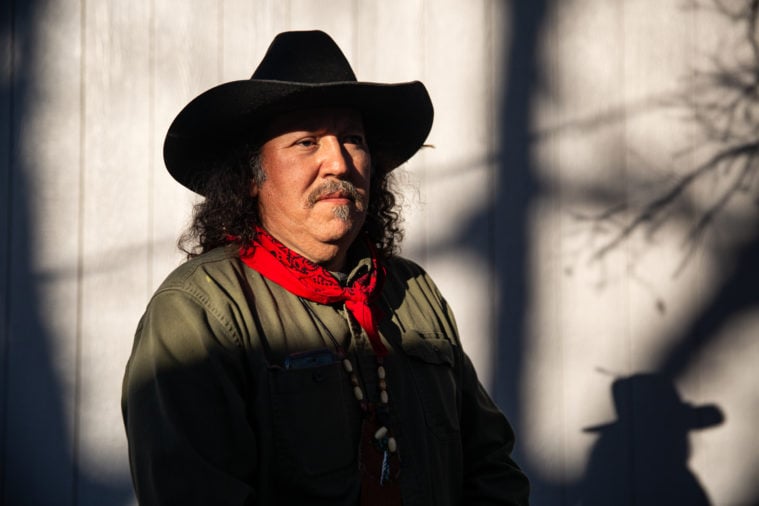
Garza’s long curly hair spills out of his felt hat, stuck with a feather. A knife hangs in a decorated leather sheath from his belt. He grew up in this town of fewer than 2,000. His parents were sheep shearers. Four generations of his family are buried in a cemetery only a short walk away. Still, as a child, he wondered where he belonged. The Anglos made fun of his English and the Mexicans made fun of his Spanish.
When Garza was a teenager, an uncle used to sometimes visit from Dallas, and he would say Garza’s grandparents described their family as Apaches. But Garza’s father always denied that.
Garza knew only what rural Texas public schools taught him: The Apaches were long gone. It wasn’t until the investigative efforts of other leaders of his generation that he learned the history of Brackettville and of the nearby Indian War fort around which it was built.
When he was a kid, there was no Apache culture evident at family gatherings. But at their gathering today, women wear Apache dresses and the boys beat homemade drums, tanned hides stretched over kitchen pots. A White Mountain Apache man named Shawn from an Arizona reservation had married into the family. Each month for a year now, he has built a sweat lodge and led prayers in his Apache language. Fifteen boys and men aged 12 to 65 sing Apache songs they’ve practiced for these gatherings. Later, they break for tacos as a remix of Selena’s Tejana cumbia plays over a loudspeaker.
Garza said he is most grateful that his two daughters now know they are Apache, and that they feel an older cultural tie to their homeland they can tap into for both wisdom and peace.
“Our family is still alive. They didn’t slaughter everyone,” Garza said. “We are slowly starting to come back.”
On the bison ranch in Waelder, Contreras cherishes the wildflowers and mesquite that remind her of youth. But she believes if she had never left the state she might not have discovered her cultural roots. She learned in San Antonio public schools in the 1980s that all of the Indigenous peoples of Texas were gone—and they didn’t seem to have anything to do with her.
When she went to college in Boulder, Colorado, in 1986, she met few Hispanics but found many other people who looked like her. They were Lakota, Navajo, and Hopi, and they asked what tribe she came from. She told them she didn’t know. Her family came from Mexico. Her new friends told her to go home and ask.
Back in San Antonio, she questioned her dad, Joe Contreras, who was born in 1927 in Laredo. His own father had died when he was only three, leaving his mom, originally from a village in north Mexico, to raise four children while picking cotton. Joe spent most of his adult life on U.S. Air Force bases in South Texas after a stint in Korea.
“Mi mamá siempre decía que somos Apache,” he told Contreras. My mother always told us we were Apache.
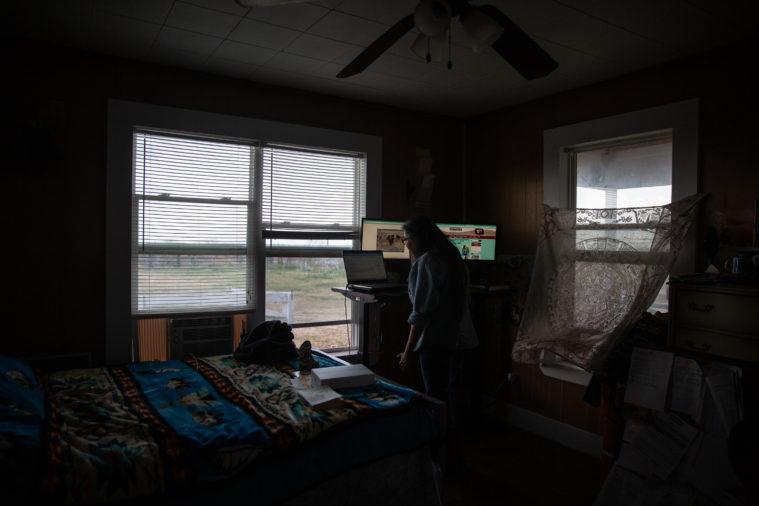
Stunned, she asked why he’d never told her about her roots before. Joe answered: “We weren’t supposed to tell anybody that we were Apache.”
Contreras had met her grandma, Ramona Rodriguez Contreras, a rough lady born in 1890, as a little girl. Rodriguez Contreras made a lasting impression when she popped the eyeball from a steaming baked cow head and ate it as the rest of the family sat around making tamales. It was extra weird since Grandma Ramona also had a glass eye.
But Grandma Ramona had died when Contreras was only 10; there was no chance to ask more questions. Instead, Contreras would spend her adult years trying to unpack, honor, and draw strength from what little her father could tell her.
In 1999, Contreras visited Grandma Ramona’s tiny northern Mexican town of Candela, Coahuila, and found papers with Ramona and her family’s names on a document stored inside wooden chests in the church archive. Ramona Rodriguez Contreras was 12 when she, her parents, and siblings registered in the village—the only time anyone in the family did so. Records showed they lived miles away in the rugged Pajaros Azules mountains.
It wasn’t much, but this was a piece of a larger history that began to come together for Contreras in the early 2000s. At that time, she was living with her husband Enrique Maestas, who identifies as Lipan Apache and was doing a Ph.D. in anthropology at the University of Texas at Austin, studying the history of native people in South Texas (the pair divorced in 2006).
In 2003, Maestas finished a 680-page dissertation about the Lipans, telling the long story of the tribe’s displacement from Central Texas across the Rio Grande until they and the other remnants of the Indigenous peoples of Texas were hunted by the U.S. Army to their final holdouts in the rugged highlands of northern Mexico, the same area Contreras’ grandmother had lived in as a girl.
Many other Texas tribes were granted reservations through treaties—the Mescalero Apaches in New Mexico in 1873, the Tonkawa in Oklahoma 1885, the Kiowa Apaches and Comanches in Oklahoma in 1901, the Tiguas near El Paso 1969, and the Kickapoo near Del Rio in 1985. The Lipans were said to have vanished and got nothing.
Instead, Lipans had dispersed, intermarried, moved across the border, or just hunkered down and stopped talking about their traditions—except among close family members, Maestas learned in his research.
“This study tells of Texas Indian and Native American survival,” Maestas wrote in his 2003 dissertation. “Writing them off as mestizos perpetuates exaggerated reports of Texas Indian extinction.”
Lipan Apaches played a prominent role in early Texas history that still doesn’t appear in state textbooks. They were an easternmost band of the mighty Apache, an interrelated group that spoke similar languages and conquered a wide country from the Rio Grande to the Grand Canyon several centuries before the Spanish arrived. The Lipan lived hundreds of miles east of their more famous cousins—the Western Apaches, led by figures like Geronimo who fought the U.S. Army in Arizona and New Mexico well into the 20th century.
The Lipan Apaches followed buffalo on the plains that swept through Central and South Texas and into northern Mexico. In the late 1700s, they were early settlers at the first Spanish missions in Texas, where they sought refuge from raiding Comanches, their most dreaded foe. In the 1800s, some bands of Lipans in Central Texas fought alongside Anglo newcomers in the war with the Comanches, and rode with the Texas Rangers. But that service wouldn’t earn them any place in the new Texas, as Maestas wrote in his dissertation, now stored in the online archives of the University of Texas.
Anglos filled up the Lipans’ Central Texas homeland and pressed the bands towards the Rio Grande. After independent Texas joined the United States in 1845, the U.S. Army brought its Indian Wars to the southwestern frontier. It built a line of forts to fight the conglomerated remnants of displaced tribes that still raided white settlements in Texas.
The Army seized key water sources in the arid country, including Las Moras Springs in Brackettville, where cool water from underground nurses a green grove of ancient live oaks in the otherwise yellow-beige scrubland.
Here, the Army found a band of Lipans in 1853, whom they evicted to build Fort Clark. But there’s no mention of attacks on local Lipan villages in the small history museum standing today at the fort, a sprawling, 2,700-acre complex of neighborhoods, resort-style amenities, and a historical site. One exhibit notes the archaeological evidence for 6,000 years of human habitation at the springs, and one small placard says some Lipan scouts served the Army but were forced to flee or conceal their identities.
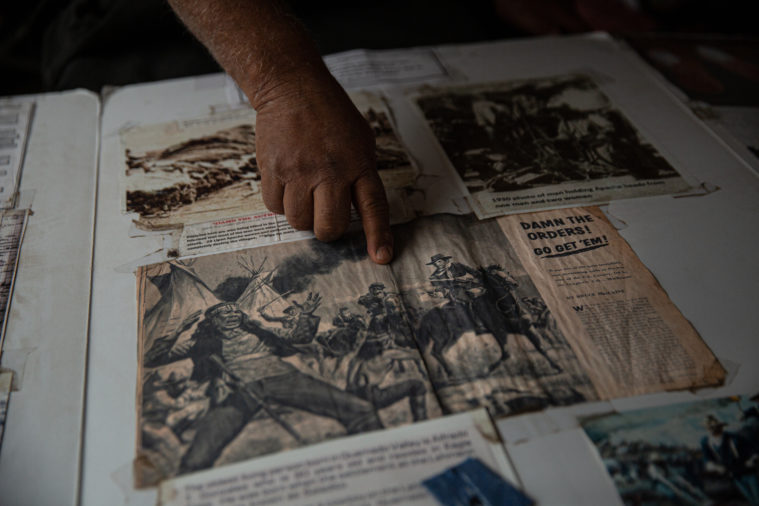
Only records stored in the dusty archive room behind a rustic padlocked door and in a row of metal drawers tell the story of Lipans who were forced from the springs, and about the subsequent military campaign against them. Those records recount how cavalry detachments dispatched from Fort Clark sought and attacked local villages where Lipans lived with Kickapoos, Kiowas, Mescaleros, and even their old enemies, the Comanches. Soldiers burned their lodges and all the possessions they couldn’t carry, yet many inhabitants escaped. Increasingly, the Indigenous people went into hiding or sought refuge in Mexico.
Frustrated, the Army in 1873 called in a star “Indian fighter,” a West Pointer from New York City named Ranald Mackenzie. Mackenzie’s right-hand man, an officer named Robert Carter, wrote a book published in 1935 about the subsequent massacres and their other exploits:
“When you begin, let it be a campaign of annihilation, obliteration, and complete destruction, as you have always in your dealings done to all the Indians you have dealt with, etc. I think you understand what I want done,” were the orders that Mackenzie received when he reported to Fort Clark.
In one bloody raid, Mackenzie marched about 400 men 30 miles into Mexico to strike the Lipan, Mescalero, and Kickapoo village at El Remolino. Carter recounts that he accidentally shot two toddlers there. Though Mackenzie reported 19 killed, Carter wrote, “Many more were counted by several officers at various distances from the villages, and in and out of the way places where they had fled for safety. … The exact number will never be known.”
The raids from U.S. Army detachments based at Fort Clark continued, attacking Native villages in northern Mexico. After a band of Lipans killed and robbed settlers in Texas, an Army detachment chased them to Coahuila’s Burro Mountains.
Here they spied the Indian camp some two miles distant in a rough and broken country. … At daybreak [General] Bullis and his scouts rushed the Indian village. By complete surprise, they slaughtered the Lipans and recovered the loot.
There was no major Lipan resistance in Texas after that.
Today, Lipan Apache teepees can be seen again near Las Moras Springs. They are set up one weekend each March, when Fort Clark hosts a living history day. The public turns out for U.S. Army reenactments, live cannon fire, live music, and carnival food.
Over the last decade, the event has also become a sort of Lipan family reunion. In March 2022, members of the Lipan Apache Band traveled here from Louisiana, Los Angeles, and Mexico for the weekend of Apache culture amid a celebration of military history at the old Indian War fort.
On one sunscorched day, Contreras sold buffalo steaks from a shaded table with her eldest son, Josekuauhtli. Nearby, Garza raffled off handicrafts made by Lipan elders in Brackettville.
As curious visitors approached, they were met by Richard Gonzalez, the towering vice chairman of the Lipan Apache Band of Texas, who dressed for the weekend in special regalia: He wore calf-high moccasins he made from an elk he shot, a satchel he made from a javelina skin, and a red neckerchief like his father and grandfather always wore.
Gonzalez told visitors he got some dirty looks when he first started setting up his teepee at Fort Clark 17 years ago. One man pressed the brim of his rustic cavalry hat close to Gonzalez’s forehead and asked him if he didn’t feel outnumbered there.
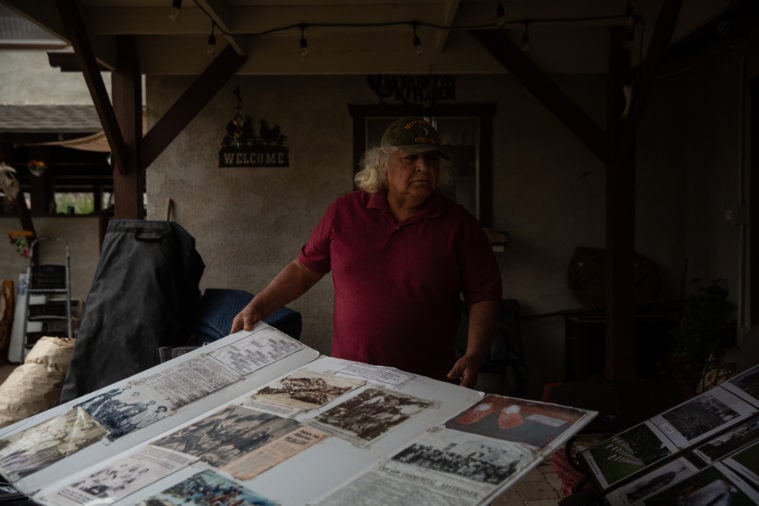
But Gonzalez, a burly Vietnam War veteran and retired career police officer, isn’t easily spooked. He said he’s dealt with that sort of thing all his life. His purpose wasn’t to fight or accuse anyone—just to stand up for his people’s right to exist and rectify their omission from history. After a short exchange, the man in the cavalry hat walked off, but later returned to apologize and Gonzalez considered their encounter a success.
Inside the teepee, visitors could find the display boards that Gonzales and his wife, Anita, set up about 30 times each year at schools or cultural events to speak up for South Texas Lipan history.
There’s an old photo showing the sad eyes and weathered face of Gonzalez’s great grandmother, Juanita González Castro de Cavazos, who was seven years old when Mackenzie’s expedition from Fort Clark attacked her village of El Remolino. She walked 325 miles to San Juan, Texas, with a small band of survivors, and later bade her own 14 children to leave Texas and never reveal their Apache roots. That’s how Gonzalez’s family ended up picking crops in California.
Next to Juanita is a photo of her daughter, Richard’s grandmother, Paulita Cavazos de Lozano, born in 1890 just south of Reynosa. Then 72, she wore an Apache dress and lived in a farmworkers’ neighborhood of Fresno, California, in 1962 on the day she told 12-year-old Richard her mother’s story.
There’s also a photo, scanned from a book, of men in northern Mexico holding five severed Apache heads that they would turn in for bounty in 1930.
That photo, he said, explains why his parents’ and grandparents’ generations kept their Apache heritage secret, even from their children. “If they would have attempted to continue to practice their culture, I wouldn’t be here,” he said.
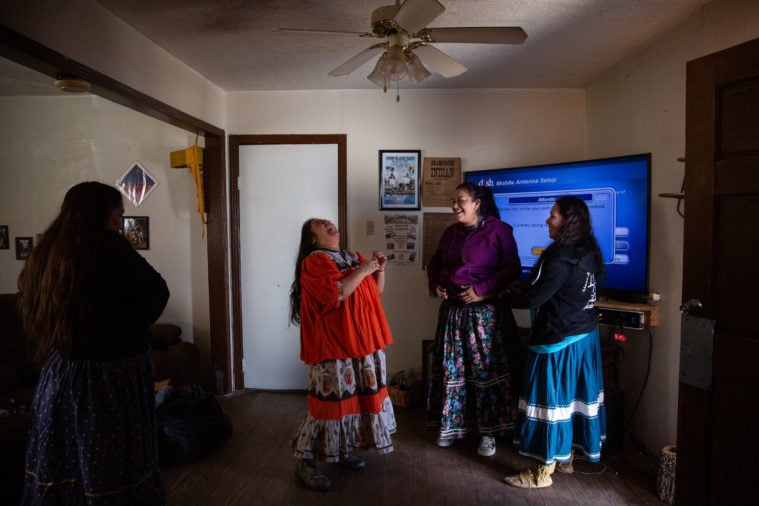
This is a case Gonzalez has spent decades assembling. When he retired in 2003, he kept diving deeper. He moved to San Antonio in 2007 and then bought a house in Fort Clark, where he flew a Lipan flag—even though vandals pulled it down at night. He scoured the state for almost 20 years, drawing information from small San Antonio historical societies, Latin records from Spanish missions, data from Mormon Family History Centers, and heaps of documents from other local archives and museums.
There are records of births, baptisms, border crossings, marriages, deaths, deals, and petitions, documenting six generations of Gonzalez’s family back to the Lipan Chief Castro de Cuelgas, who appears in early Anglo stories of the friendly Texas Lipans. It’s all spelled out on three yards of poster paper with more than 300 names in a giant family tree that students at the University of Texas at San Antonio printed using Gonzalez’s genealogical records as part of a class exercise.
In the beginning, all of this effort was aimed at earning federal recognition for the Lipan Apache—legal affirmation of their continued existence and access to funding from the Bureau of Indian Affairs. But, as that bureaucratic effort stalled for years, the archive became more meaningful for him as proof that his own family’s roots were real. Now, it’s bundled into various fire-proof safes and filing cabinets in his house alongside family heirlooms and the artwork Gonzalez makes.
He was striking back against people like the secretary at a San Jose public school in 1990 who used Wite-Out where Gonzales had written “Lipan Apache” for his son’s race and instead wrote “Hispanic,” then explained the change was “because of your last name.” He was providing proof to his own descendants and the youngsters of his community so they could claim their roots sooner than he did.
Almost 100 Lipan Apaches turned out for the 2022 weekend at Fort Clark. After the public exhibitions ended, they went to a nearby campground to share an extended family meal of venison stew and a taco bar. Around a bonfire at night, a group of Apaches visiting from an Arizona reservation danced the sacred Apache crown dance for the Lipans and led them in Apache language songs, which many of the Brackettville youth had been practicing.
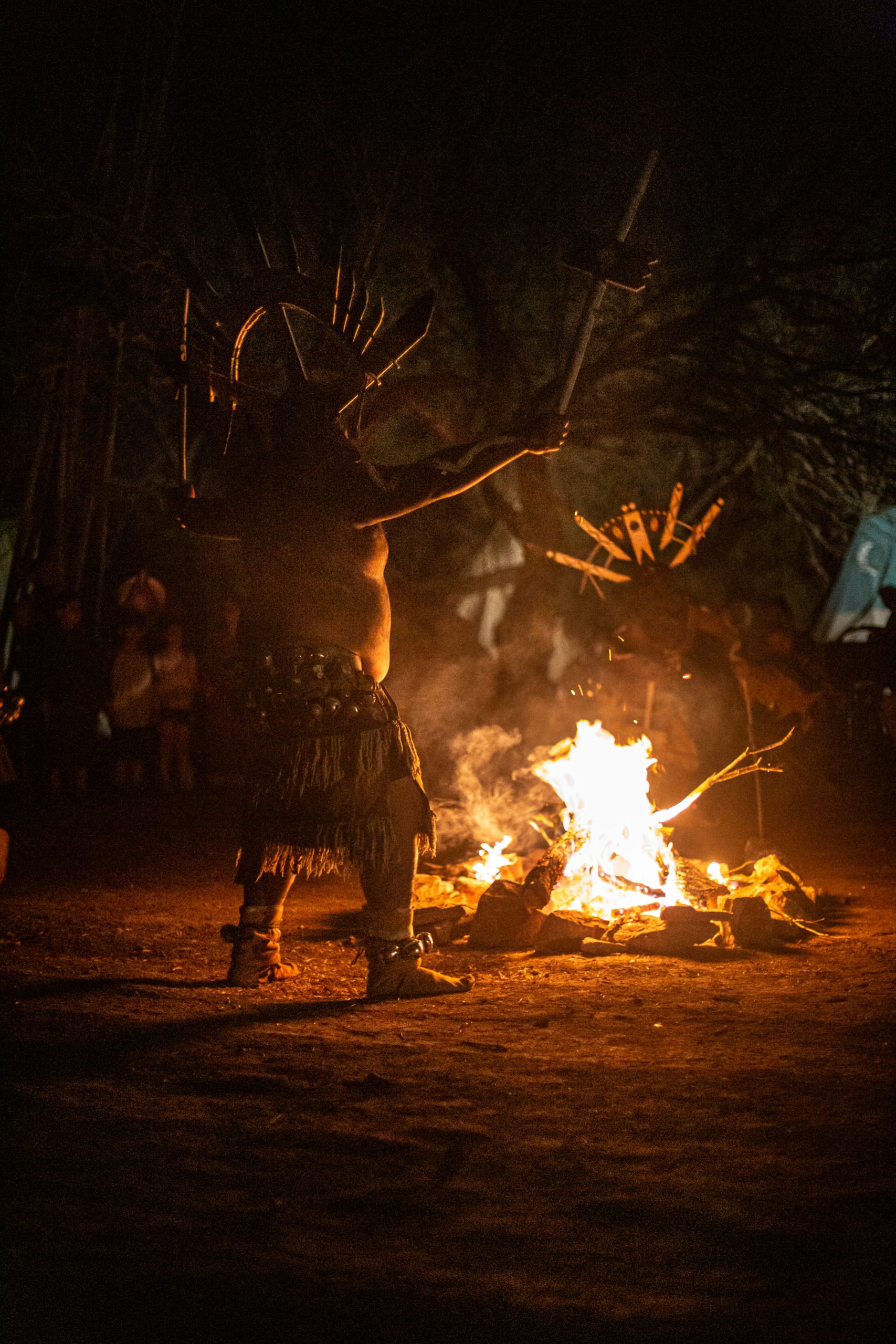
Contreras is grateful to Gonazalez and the leaders who made the Lipans of Texas into the community they are today. She looks forward to being part of the emergence of a new generation of women leaders.
Specifically, she wants to share the buffalo culture she learned from the Lakota during her six years on the Pine Ridge Reservation, where she worked and studied with the Knife Chief Buffalo Nation Society. The Pine Ridge Reservation is a hallowed spot in Native American history, a final holdout of free natives and the place where the Plains Indian Wars ended with the massacre at Wounded Knee in 1890. More than many other tribes who were crushed early on, the Lakota kept big parts of their culture intact, Contreras said.
The Lakota “hold so strongly to the Buffalo Nation teachings,” she said. “The Lipan Apache are Buffalo Nation too, but we’ve been dissociated from our land, from each other for so long.”
The idea for a Texas buffalo ranch brewed long in Contreras’ mind. She believed that that kind of exhibition of Native American culture—and that feeling of inspiration—was missing in Texas, and Contreras wanted to help bring it back, starting by reclaiming one plot of Lipan land.
Early morning on Good Friday in April, Contreras opened the door of her white wooden ranch home to find a new bison calf suckling its mother in the tall spring grasses of her pasture. It was the first birth since she started her small herd in 2021.
She has only 77 acres and now ten bison, but believes that someday, with the way things are going, she or her descendants will have many, many more.
